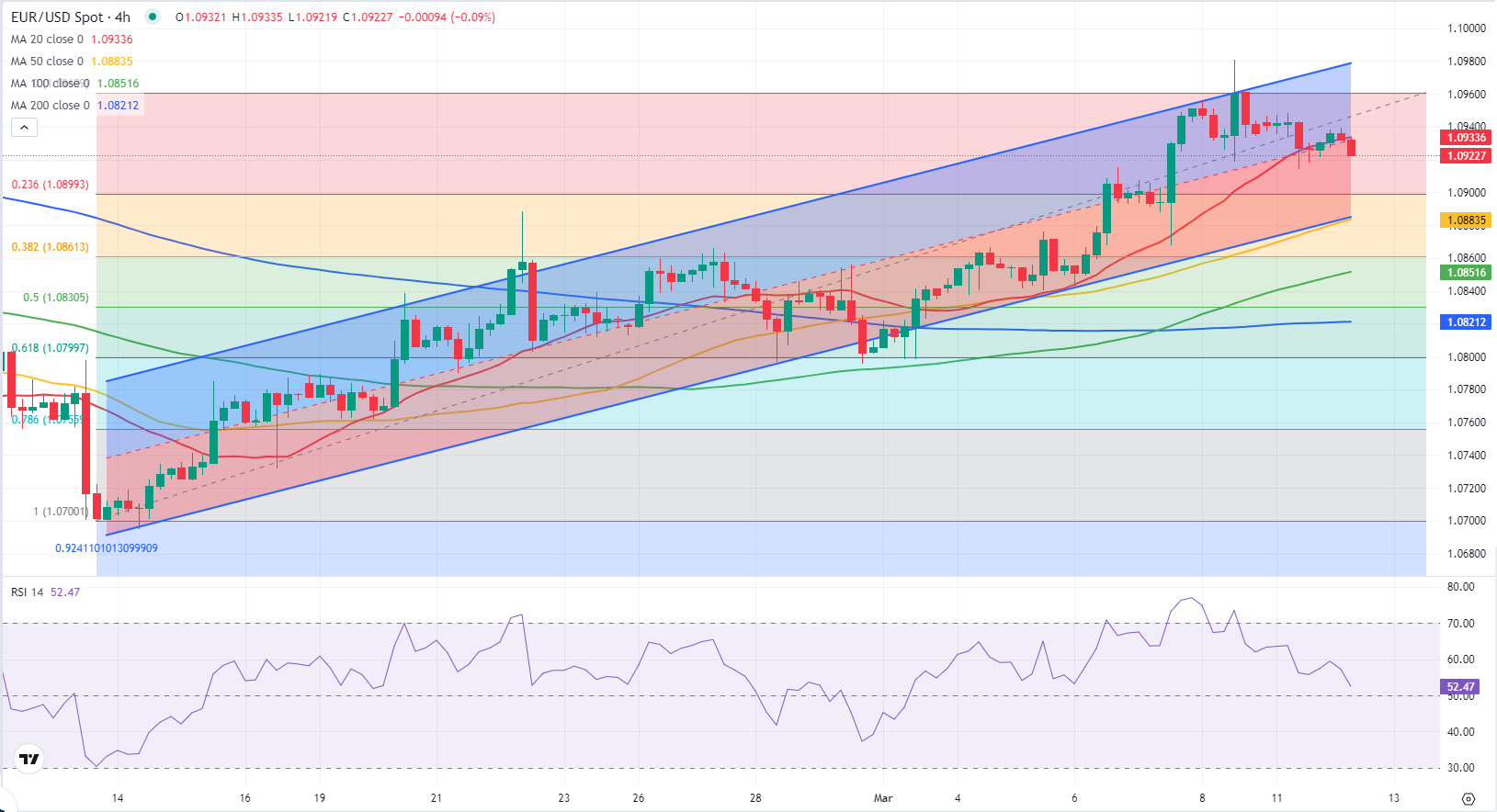- EUR/USD stays below 1.0950 after closing in the red on Monday.
- Investors await US Consumer Price Index data for February.
- Near-term technical outlook points to a loss of bullish momentum.
EUR/USD is struggling to regain its traction and trading below 1.0950 early Tuesday after closing in negative territory on Monday. The pair's near-term technical outlook points to a loss of bullish momentum ahead of the key Consumer Price Index (CPI) data from the US.
The cautious market mood at the beginning of the week helped the US Dollar (USD) stay resilient against its rivals and forced EUR/USD to stay on the back foot.
Euro price this week
The table below shows the percentage change of Euro (EUR) against listed major currencies this week. Euro was the weakest against the Canadian Dollar.
| USD | EUR | GBP | CAD | AUD | JPY | NZD | CHF | |
| USD | 0.17% | 0.55% | -0.08% | 0.13% | 0.38% | 0.26% | -0.10% | |
| EUR | -0.17% | 0.38% | -0.26% | -0.04% | 0.20% | 0.08% | -0.26% | |
| GBP | -0.55% | -0.38% | -0.63% | -0.41% | -0.15% | -0.29% | -0.65% | |
| CAD | 0.08% | 0.24% | 0.62% | 0.21% | 0.43% | 0.33% | -0.02% | |
| AUD | -0.13% | 0.04% | 0.40% | -0.22% | 0.25% | 0.13% | -0.24% | |
| JPY | -0.37% | -0.19% | 0.41% | -0.47% | -0.22% | -0.11% | -0.47% | |
| NZD | -0.26% | -0.10% | 0.27% | -0.36% | -0.13% | 0.12% | -0.35% | |
| CHF | 0.09% | 0.26% | 0.64% | 0.02% | 0.27% | 0.47% | 0.36% |
The heat map shows percentage changes of major currencies against each other. The base currency is picked from the left column, while the quote currency is picked from the top row. For example, if you pick the Euro from the left column and move along the horizontal line to the Japanese Yen, the percentage change displayed in the box will represent EUR (base)/JPY (quote).
The US Bureau of Labor Statistics (BLS) will release the February CPI data on Tuesday. On a yearly basis, the CPI inflation is forecast to hold steady at 3.1%. The Core CPI, which excludes volatile food and energy prices, is expected to rise 3.7%, at a softer pace than the 3.9% increase recorded in January. On a monthly basis, the Core CPI is seen rising 0.3%.
In case the Core CPI comes in above the market expectation, the initial reaction could help the USD to extend its recovery and weigh on EUR/USD. On the other hand, a reading of 0.2% or lower could make it difficult for the USD to find demand.
According to the CME FedWatch Tool, markets are currently pricing in a nearly 70% probability that there will be a Federal Reserve (Fed) rate cut in June. This market positioning suggests that there is room for further USD weakness if the inflation data allow investors to confirm a policy pivot in June.
EUR/USD Technical Analysis
The Relative Strength Index (RSI) indicator on the 4-hour chart retreated toward 50 and EUR/USD closed the last 4-hour candle below the mid-point of the ascending regression channel and the 20-period Simple Moving Average, highlighting buyers' hesitancy.
On the downside, 1.0900 (Fibonacci 23.6% retracement of the latest uptrend) aligns as next support before 1.0880 (lower limit of the ascending channel, 50-period SMA) and 1.0850-1.0860 (Fibonacci 38.2% retracement, 100-period SMA).
1.0960 (end-point of the uptrend) could be seen as first resistance on the upside before 1.0980 (upper limit of the ascending channel) and 1.1000 (psychological level, static level).
Euro FAQs
The Euro is the currency for the 20 European Union countries that belong to the Eurozone. It is the second most heavily traded currency in the world behind the US Dollar. In 2022, it accounted for 31% of all foreign exchange transactions, with an average daily turnover of over $2.2 trillion a day. EUR/USD is the most heavily traded currency pair in the world, accounting for an estimated 30% off all transactions, followed by EUR/JPY (4%), EUR/GBP (3%) and EUR/AUD (2%).
The European Central Bank (ECB) in Frankfurt, Germany, is the reserve bank for the Eurozone. The ECB sets interest rates and manages monetary policy. The ECB’s primary mandate is to maintain price stability, which means either controlling inflation or stimulating growth. Its primary tool is the raising or lowering of interest rates. Relatively high interest rates – or the expectation of higher rates – will usually benefit the Euro and vice versa. The ECB Governing Council makes monetary policy decisions at meetings held eight times a year. Decisions are made by heads of the Eurozone national banks and six permanent members, including the President of the ECB, Christine Lagarde.
Eurozone inflation data, measured by the Harmonized Index of Consumer Prices (HICP), is an important econometric for the Euro. If inflation rises more than expected, especially if above the ECB’s 2% target, it obliges the ECB to raise interest rates to bring it back under control. Relatively high interest rates compared to its counterparts will usually benefit the Euro, as it makes the region more attractive as a place for global investors to park their money.
Data releases gauge the health of the economy and can impact on the Euro. Indicators such as GDP, Manufacturing and Services PMIs, employment, and consumer sentiment surveys can all influence the direction of the single currency. A strong economy is good for the Euro. Not only does it attract more foreign investment but it may encourage the ECB to put up interest rates, which will directly strengthen the Euro. Otherwise, if economic data is weak, the Euro is likely to fall. Economic data for the four largest economies in the euro area (Germany, France, Italy and Spain) are especially significant, as they account for 75% of the Eurozone’s economy.
Another significant data release for the Euro is the Trade Balance. This indicator measures the difference between what a country earns from its exports and what it spends on imports over a given period. If a country produces highly sought after exports then its currency will gain in value purely from the extra demand created from foreign buyers seeking to purchase these goods. Therefore, a positive net Trade Balance strengthens a currency and vice versa for a negative balance.
Information on these pages contains forward-looking statements that involve risks and uncertainties. Markets and instruments profiled on this page are for informational purposes only and should not in any way come across as a recommendation to buy or sell in these assets. You should do your own thorough research before making any investment decisions. FXStreet does not in any way guarantee that this information is free from mistakes, errors, or material misstatements. It also does not guarantee that this information is of a timely nature. Investing in Open Markets involves a great deal of risk, including the loss of all or a portion of your investment, as well as emotional distress. All risks, losses and costs associated with investing, including total loss of principal, are your responsibility. The views and opinions expressed in this article are those of the authors and do not necessarily reflect the official policy or position of FXStreet nor its advertisers. The author will not be held responsible for information that is found at the end of links posted on this page.
If not otherwise explicitly mentioned in the body of the article, at the time of writing, the author has no position in any stock mentioned in this article and no business relationship with any company mentioned. The author has not received compensation for writing this article, other than from FXStreet.
FXStreet and the author do not provide personalized recommendations. The author makes no representations as to the accuracy, completeness, or suitability of this information. FXStreet and the author will not be liable for any errors, omissions or any losses, injuries or damages arising from this information and its display or use. Errors and omissions excepted.
The author and FXStreet are not registered investment advisors and nothing in this article is intended to be investment advice.
Recommended Content
Editors’ Picks

EUR/USD holds losses near 1.1350 ahead of ECB policy decision
EUR/USD stays on the back foot near 1.1350 in European session on Thursday. The pair loses ground on the back of a broad US Dollar rebound and as traders turn cutious ahead of the European Central Bank interest rate decision and Lagarde's press conference.

Gold price retreats from record high as profit-taking kicks in
Gold price retreats after touching a fresh all-time peak earlier this Thursday and erodes a part of the previous day's blowout rally though the downside remains cushioned. A slight improvement in the global risk sentiment, bolstered by hopes of US trade negotiations, turns out to be a key factor undermining the precious metal.

GBP/USD stays offered below 1.3250 as US Dollar attempts a bounce
GBP/USD remains under pressure below 1.3250 in Thursday's European trading, snapping its seven-day winning streak. A tepid US Dollar recovery amid risk appetite prompts the pair to pullback from six-month highs of 1.3292 set on Wednesday. Traders look to tariff headlibnes and US data for fresh impetus.

RAY sees double-digit gains as Raydium unveils new Pumpfun competitor
RAY surged 10% on Wednesday as Raydium revealed its new meme coin launchpad, LaunchLab, a potential competitor to Pump.fun — which also recently unveiled its decentralized exchange (DEX) PumpSwap.

Future-proofing portfolios: A playbook for tariff and recession risks
It does seem like we will be talking tariffs for a while. And if tariffs stay — in some shape or form — even after negotiations, we’ll likely be talking about recession too. Higher input costs, persistent inflation, and tighter monetary policy are already weighing on global growth.

The Best brokers to trade EUR/USD
SPONSORED Discover the top brokers for trading EUR/USD in 2025. Our list features brokers with competitive spreads, fast execution, and powerful platforms. Whether you're a beginner or an expert, find the right partner to navigate the dynamic Forex market.
